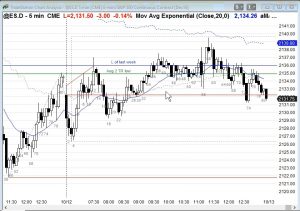Trading room advice traders can follow?
BPA trading room Q&A: October 12, 2016
Question: In a prior Q&A that was just posted as a [Ask Al] video, you understandably advised people not to blindly follow, or mimic any trading guru, yourself included. Given that, how do you recommend people utilize the daily webinar to be profitable traders?
Apologies for some bad mic handling noise impractical to remove.
Video duration: 3min 48sec
You can also view this video on Al’s YouTube Channel if needed.
Learn to look at the market
 I’m hoping that I try to provide a way to look at the markets. I scalp most of the time because I just see stuff on every bar. I’m taking little scalps all day long. But I also talk about [the big] picture and if you’re able to trade small enough, especially if you’re able to scale in, and I say bar 5, bar 6 is Always In Long. If you want to do anything, you buy the 5 close or you buy the 6 close, or you buy the 8 low. That ‘Always In’ comment that I make throughout the day, those are all reasonable times to enter the market and then use the appropriate stop. Usually when I say I ‘Always In’, I say “OK, it’s Always In Long 5, or Always in Long 6, stop down here”. “Always In Short, maybe, maybe stop up here”. I’ll talk about where the stops are and beyond that, just learn.
I’m hoping that I try to provide a way to look at the markets. I scalp most of the time because I just see stuff on every bar. I’m taking little scalps all day long. But I also talk about [the big] picture and if you’re able to trade small enough, especially if you’re able to scale in, and I say bar 5, bar 6 is Always In Long. If you want to do anything, you buy the 5 close or you buy the 6 close, or you buy the 8 low. That ‘Always In’ comment that I make throughout the day, those are all reasonable times to enter the market and then use the appropriate stop. Usually when I say I ‘Always In’, I say “OK, it’s Always In Long 5, or Always in Long 6, stop down here”. “Always In Short, maybe, maybe stop up here”. I’ll talk about where the stops are and beyond that, just learn.
Market noise?
I see these dumb gurus talk about noise and I just don’t understand it. To me, when a person talks about noise, they just don’t understand what’s going on with the market. They don’t understand what the market’s doing, what it’s trying to do. They don’t understand the forces that are at play. Nothing is noise. Everything happens for a reason. Every time the market turns at a certain price, there’s a reason. It’s not some random noise event. There was enough money making it happen, enough computers seeing what’s going on to make it happen.
Getting good – then scalp!
I also talk a lot about scalps. A lot of them I take, a lot of them I don’t take. If you get really good as a trader, what you’ll find yourself doing is taking more and more, smaller and smaller, and smaller trades. Not necessarily but a lot of traders do that. The better they get, the more stuff they see and, you say, “Should I buy that? Should I buy the 17 close? Should I buy the 6 close? Right?”
That little man again
 If you’ve been trading a long time, the way I look at it is: it’s like some little guy, with his arm outstretched, holding a little bag filled with a few gold coins. I keep telling him “Yes” all day long, and get all those gold coins and put them in my pocket. Allof a sudden, I’ve got a lot of gold. Or I could say, “No, it’s too small for me to bother with.” For me, I see the stuff. I see the little man with the little bag of gold, and I just keep taking gold from him, all day long. So as time goes on, you’ll begin to anticipate certain high probability bets, like as soon as 6 closes, you just hit ‘Buy the Close’ — and you just try to get a couple points out of it.
If you’ve been trading a long time, the way I look at it is: it’s like some little guy, with his arm outstretched, holding a little bag filled with a few gold coins. I keep telling him “Yes” all day long, and get all those gold coins and put them in my pocket. Allof a sudden, I’ve got a lot of gold. Or I could say, “No, it’s too small for me to bother with.” For me, I see the stuff. I see the little man with the little bag of gold, and I just keep taking gold from him, all day long. So as time goes on, you’ll begin to anticipate certain high probability bets, like as soon as 6 closes, you just hit ‘Buy the Close’ — and you just try to get a couple points out of it.
Major trend reversals
Beyond that, I talk about major trend reversals and coming into today, I said today we would probably have a major trend reversal and an attempt at a second leg up after yesterday. So, you could be looking to buy reversals up from sell-offs, above 4, probably not, but 5 close and 6 close, yes. And then here, above 23 maybe. Above 29, maybe. Then near the high when we’re failing at the moving average, and I’m saying all day long that’s probably going to get down to the open of the day. Sometimes what I’ll do is, on a day like this where the range is going to be about 10 points or something, and you’re 4 or 5 points away from the open, in one of my accounts, I’ll just place an order, risking 4 points to make 4 points approximately. So if I’m 4 points above the open, I’ll just sell and put a stop 4 points above, betting that it’s more likely that we’re going to get to the open, than it is to my stop.
Al Brooks
Information on Al’s Online day trading room

